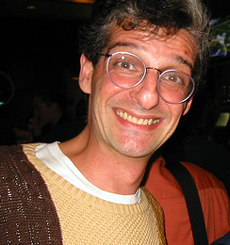Saturday, October 09, 2004
Genocentrism aids Anti-Abortion Arguments
Life begins, takes its course, and ends.
The course of Life determines the directionality of Time. Without Life, it would be impossible to determine which way the Time goes, what is Past and what is Future.
Every living organism dies, ashes to ashes, dust to dust, Life becomes Non-Life.
But, when does Non-Life become Life? This seems to be the key question in the discussions about abortion, stem-cell research, and other touchy political/religious topics.
Usual answers: at the time of fertilization, or 40 days after, or at the time of completion of development of the neural tube, or brain, or heart, or pain receptors, or at the time self-awareness kicks in (humans only), or at birth (or at five months, three weeks, six days and nineteen hours, see the semi-serious satire here: http://ravingatheist.com/archives/2004/10/ua5.php). The sheer number of responses, as well as temporal ambiguity of at least half of them, suggests there is something fishy about the answers, or the question.
The trouble is with our notion that Life comes from Non-Life over and over again, for each individual separately. Historically, the question was framed as a dispute between epigenetics and preformationism. This history was masterfully outlined in the first half of the influential Gould's "Ontogeny and Philogeny" (book that spawned a whole new and exciting discipline: evo-devo), and the dispute within the preformationist camp between homunculus-in-egg and homunculus-in-sperm beliefs was beautifully rendered in a book by Gould's postdoc, Clara Pinto-Correia in "The Ovary of Eve".
In epigenetics, "parts" of the future embryo are contained in the egg. Fertilization is needed to trigger a process, a "program", that will put the pats together and form a new organism. In preformationism, a tiny little organism is found fully formed within either the egg or the sperm and, upon fertilization, just grows towards its final size.
Epigenetics makes it relatively easy, though not perfect, to think of fertilization as the moment when life begins. It is more difficult for preformationists: fertilization is just a trigger for an already existing person to start growing. You were a little person inside your mother's egg. Eve's ovary contained eggs that contained daughters whose eggs contained daughters whose eggs contained daughters.....whose eggs contained your mother whose eggs contained you. And your eggs contain the Russian doll of all of your descendants, until the Apocalipse. Same logic applies to the sperm version of the story.
This was the debate that raged mainly during 17th through 19th century. Before that, it was not even known that mammals had eggs. The 40-day rule was purely practical - that was the earliest time one could know if one was pregnant.
Fast-forward to the end of 20th century. The common wisdom is that epigenetics won. Instead of parts being already present in the egg, they are produced by action of the genes and the genes also run the "computer program" for putting the parts together. More recent research indicates that some "parts" are already present in the egg, e.g., maternal RNAs, proteins and hormones, but this does not substantively shange the logic of the story.
But if one looks with greater detail into writings of the most influential writers like Dawkins, a different story emerges. This, to me, looks like preformationism. If we are just "lumbering robots" and the mere "vehicles" for our genes, if the genes are what really counts, and genes are existing forever moving from one generation to another - isn't that also a Russian doll metaphor? In the beginning there was a gene, and the gene keeps replicating and travelling through time through a bunch of disposable bodies. That is preformationism.
If one looks closely, both the "program" view of the gene, and the Dawkinsian view of the gene eliminate the time of fertilization as the beginning of Life. Life came from Non-Life about 4 billion years ago. Once. That's it. It is a branching bush with one root and gazillions of twigs. Root stays put, the twigs die. There was only one birth on this planet and googlillions of deaths.
So, why does this notion of "Life Begins at Birth" survive into the 21st century? Because DNA is just a molecule. It is dead. It can sit in a test-tube (or in pretty yellow rocks that owners of "Jurassic Park" can use) forever. So why can't it sit tight inside an egg and wait a while for its time to come? That is how most people in the street think of it. Egg is a computer. Sperm is a floppy-disk. DNA is sofware. Some software is already on the computer, the rest comes on the floppy. Once you put the disk in the computer, the program runs and, voila, here's an embryo. In the meantime, the computer mey not even be plugged in and the disk is collecting dust. But the POTENTIAL is always there. Thus, Life easily begins at the moment of fertilization. Over and over and over again, through the billions of years of the history of the planet. Life arises de novo. Life out of Non-Life. I thought they taught us in school that Louis Pasteur had something to say about this.
As long as the public believes that everything important about us is written in our genes ("program"), or that we are just a gene's way of making more genes ("selfish gene"), the possibility for declaring the time of fertilization as the time life begins will persist.
The alternative, something along the lines of Developmental Systems Theory (see my previous two posts about genes), puts the beginnnig of ALL life, every single organism, back into the primal soup. We are all parts of a very long continuum. One day each one of us will die at our own dates and times, but we were all born simultaneously a long time ago - about 4.5 billion years ago. Thus, killing some sperm, or an egg, or an embryo, or a fetus, or a child, or an adult, or an elderly person (or a cockroach, or a staphilococcus, or a mouse, or a chicken, or a head of cabbage) all amount to the same thing - end of one branch on the tree of life. But the tree itself is fine, thank you, alive and growing and breathing and photosynthetizing, and some pruning of its terminal branches does not hurt it at all. Now, here is a grand perspective if you are looking for one.
Let me try to put together, into a hopefully more coherent picture, where I am going with this whole blog, over a couple of dozen past posts (scroll down and read for details on each of these points):
A) Conservatives suscribe to the Strict Father moral code;
B) Strict Father moral code is hierarchical ("moral odrer");
C) Genocentrism is hierarchical, thus appeals to conservatives;
D) Genocentrism leaves an opening for reintroduction of God into biology;
E) Genocentrism allows for the argument that Life starts at conception;
F) Argument that Life starts at conception is a prerequisite for the anti-abortion/anti-choice stance;
G) Anti-choice is a position that unites religious and social conservatives;
H) Anti-choice is consistent with the Strict Father model of control of women (and children, to some extent)by men (their last stand since they lost slaves, racism, Christian state, etc.);
I) Conservativism is on the wrong side of history and, sensing its impending doom, is fighting for its very existence;
J) Bushies are fighting dirty because they are fighting for the very existence of conservativism;
K) Defeating Bush is imperative, unless we wish to slip back into Middle Ages;
L) Abortion and related issues (stem-cell research, gay marriage, academic freedom, cloning, "sound" science, environment) are key for winning elections;
M) Reframing the debate on above issues is neccessary for beating Bush;
N) Reframing biology from (conservative) genocentrism to (liberal) interactionism is neccessary for arguments against conservative frames on social issues, especially abortion.




















